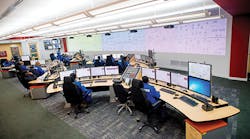As we move into 2021, we're happy to report that over the past 20 years, we at User Centered Design Services (UCDS) have worked with representatives of more than 100 organizations to help convince their management to invest in human factors. This isn't an easy undertaking. More than one engineer has removed their hardhat to pull their hair out in frustration. To an engineer, witnessing near misses, exceeded operating limits, and automated processes running in manual tells a story. That story is very clear: we can do better! We have to do better!
But where do we center our efforts to achieve “better”?
It's been studied and reported that companies’ operating costs are increasing. Many would believe that the majority of operating costs come from maintenance, utilities and equipment management. But 82% of the money goes to payroll: the workers. Yep, you heard that right. The people are the highest operating cost. Of course they're a critical component, but—are they really that important?
Meanwhile, upper management is under pressure to reduce costs. Is it any surprise they look to achieve their objectives with fewer people? Often these decision-makers are steered to a technology solution to reduce headcount. Humans seem to pose a higher risk, are hard to predict, and can make decisions that are hard to measure. They're also very expensive!
More automation isn't always better
Many engineers believe that we need to focus on automation to optimize processes and increase the number of loops an operator can handle. They want to develop solutions like "safe park"—an easy button for returning the operation to a more conservative state when something abnormal happens (almost always when running flat out). Some plants have been able to implement such solutions, but the cost is extremely high and it takes a long time to see results. Engineering complexity requires more, higher-salaried professionals to maintain the new technology-based system; they also require outside expertise and new technology. This type of project can get very expensive and risky. As evidenced by past experience, investing in technology can come back to bite you in the end. A Frankenstein creation of smart logic becomes a maintenance nightmare and a high-risk proposition because it requires human input and an exhausting analysis of potential failures.
Current projections based on the past 20 years' experience indicate the near future of industrial operations isn't going to be a technological feat that reduces or replaces the human worker. The reality is that we absolutely need humans even as we must reduce operations costs.
A focus on human performance
Many operational planners are starting to focus on human performance. Acknowledging human limitations and asking questions like: can we improve human performance—do better, achieve more, reduce risks, and accomplish the long goal? Can I lower costs by investing in the human element, the workers, and how well they perform? Can I increase human performance from an average 88% output to 95% and even 100%? How can I improve human performance and reduce the risks that human reliability poses to operations?
Knowing the majority of operating expenses is absorbed by staff poses an obvious question: isn't it logical to optimize this asset to get as much out of it as you can? Our findings answer this question with a “yes.” With the right approach and outside help you can increase and improve human performance. This requires an integrated human factors methodology that examines operational culture, worker behavior and user interfaces. To improve human performance, you have to assess, address and manage human behavior, and identify why they do what they do. The human element, your people, are the most expensive and valuable asset you have. You spend time and money maintaining your car, why not in the people who make operations possible?
For entertainment purposes, imagine your car is your business and gas is your cost. You want to drive twice the distance with the gas you have in the tank. The obvious solution would be to eliminate the need for gas. Perhaps an electric replacement or engine conversion is too expensive, and you have no choice but to use the gas you have for the next 10 years. Since you're already paying for it, why not invest in improving your gas to increase your traveling distance? A car requires gas just like your operation requires people. What if you could travel twice as far for less than you're paying now by adding a little boost juice to your gas?
Your competition may be doing just that—adding a boost to human performance. We're seeing this across the globe, with companies reducing waste, maintenance, energy, turnover time and asset costs. The most visible return we see after a project is the reduction in time the process is running outside the ideal operating envelope and the increased time running at optimal levels. The second thing that's obvious is operator morale and gratitude. Morale is a critical human factor that's directly related to safety and profit. Don't under estimate the impact it has on day-to-day decisions.
Our customers are looking at human-performance and error-free task management as alternatives to a technology-centric solution. They're assessing situational awareness, abnormal situations, job-task performance, operator workloads, worker competence, supervisory requirements and user interfaces, such as alarms and operator displays, and video- and audio-integrated workstations with large-screen overviews of critical processes.
All of these are related components that must be interconnected into the design of a control room to form what we call an integrated human-factors solution. For error-free task management, we see our customers developing programs focused on how to do the job right every time, which we classify as conduct of operations and operational discipline. These programs have a director, and start with leadership alignment, documentation and training. It’s a practice that UCDS president Ian Nimmo has been developing for more than 30 years.
Internal leadership needed
The companies that are getting the most out of human performance are the ones that appoint an internal operations performance improvement leader to work closely with outside industrial experts in human factors and operator-workload management. These leaders are successful when they integrate a human factors/human behavior program with the following guidelines:
- Newly developed, documented standards for operational tasks based on clearly defined roles, responsibilities and objectives;
- Classroom training with visual aids to ensure responsible decision-making during abnormal operations;
- Operator management systems software to aid routine tasks and decision-making to reduce variances in human performance between workers and shift teams;
- Software tools to reduce complacency and enforce compliance with a documented standard; and,
- Task assessment to identify risks of human error and get help from industrial experts to mitigate those risks (also referred to as operator task and workload assessment).
Companies are putting real performance systems in place that use technology not as a replacement but as an aid to reduce human error. Technology that's user-centered is also error-resistant. A performance boost for the human to perform at a higher and safer level requires discipline, tools, support and a great understanding of human limitations. It also needs an expert who knows all the best practices being used successfully in the control room and the field. When a human performance-based program is implemented successfully, management is happy to see its supporters were right.
Behind the byline
Steve Maddox is business development manager at User Centered Design Services Inc., a U.S.-based consultancy focused on operational excellence, with a vision of implementing best practice solutions. He can be reached at [email protected].

Leaders relevant to this article:



